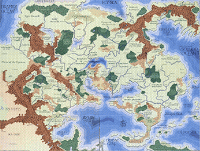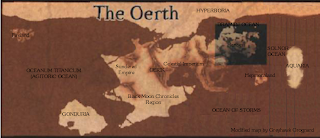 |
| Kenneth Hite |
At the recent Metatopia convention in Morristown, NJ, I attended a seminar given by Kenneth Hite (who has written a number of GURPS titles as well as many other works including two different Star Trek RPGs). During the seminar, he used the World of Greyhawk as a punching-bag, accusing it of being a mish-mash of disparate cultures stripped out of place and time and slapped down with wild abandon, leaving it suitable only for picaresque adventures (the implication being that real “story-driven adventures” would not be suitable there).
Let us say that I disagree with his assessment.
I see the Flanaess as a fairly straightforward analogue of Medieval and early Renaissance Europe. Obviously, it’s not a straight one-to-one comparison, but there are enough strong analogies there, and only a few outright inventions, but ones which serve to secure its place as an original fantasy world based on the model of Europe, rather than attempting to be an alternate history setting.
Most certainly wrong is Mr. Hite’s contention that the Flanaess consists of a wild amalgam of disparate Earth cultures. During the seminar he glibly spoke of “the Roman area” and “the Egyptian area” of the Flanaess. I confess in decades of play, study, and writing about the setting I don’t recall seeing them. Such places have been hinted at over the years in far-off regions of Oerik (particularly in the Far West, where we see places such as Erypt and the Tharquish Empire), but never actually detailed. To say they’re simply crammed into the Flanaess willy-nilly is factually inaccurate.
 The Flanaess is “guilty as charged” when it comes to having a “Viking area” (the Thilronian peninsula, where we have the Schnai, Fruzti, and Cruski barbarian nations), but that hardly disqualifies it from having a mostly pseudo-European character. The Vikings, after all, were a feature of early Medieval Europe.
The Flanaess is “guilty as charged” when it comes to having a “Viking area” (the Thilronian peninsula, where we have the Schnai, Fruzti, and Cruski barbarian nations), but that hardly disqualifies it from having a mostly pseudo-European character. The Vikings, after all, were a feature of early Medieval Europe.
The comparisons between the Flanaess and Medieval/Renaissance Europe go deeper than merely sharing a Viking-esque culture on their respective peripheries. Both have a large and unwieldy empire made up of very strong, quasi-independent states loosely governed by a central authority. In Europe this was the Holy Roman Empire, and in the Flanaess this is the Great Kingdom of Aerdy.
 The overwhelming political structure used by states throughout the Flanaess are feudal monarchies. There are, of course, exceptions; the Yeomanry is a sort of “warrior’s democracy”, while Perrenland is quite obviously closely modeled on Switzerland. The Scarlet Brotherhood is obviously an invention (although there does seem to be just a little bit of the Jesuits peaking through those scarlet robes). While it is true that there are more regions directly ruled by clerical authorities in the Flanaess than there were historically in Europe, this is not at all unusual when one considers its polytheistic nature. With multiple religious authorities, it’s only natural that there could be multiple religiously-ruled nations. And, of course, the Papal States in Italy were the model there.
The overwhelming political structure used by states throughout the Flanaess are feudal monarchies. There are, of course, exceptions; the Yeomanry is a sort of “warrior’s democracy”, while Perrenland is quite obviously closely modeled on Switzerland. The Scarlet Brotherhood is obviously an invention (although there does seem to be just a little bit of the Jesuits peaking through those scarlet robes). While it is true that there are more regions directly ruled by clerical authorities in the Flanaess than there were historically in Europe, this is not at all unusual when one considers its polytheistic nature. With multiple religious authorities, it’s only natural that there could be multiple religiously-ruled nations. And, of course, the Papal States in Italy were the model there.
Aside from these (and many other) specific comparisons, there are also more broad thematic similarities. There is the theme of regaining the lost golden age; in Europe, it was the drive to recreate the Roman Empire, while in the Flanaess it’s the lost Suel Imperium. There’s the imminent threat of a foreign culture on the doorstep; in Europe, the Muslims in Spain, the Mediterranean, and Balkans; in the Flanaess, the Baklunish in Ket and the lands beyond. The Flanaess does seem a bit more insular than Europe, but this may be a function of the fact that none of the lands of Oerth beyond the Flanaess have ever been officially described in any great detail.
As far as the suitability of the Flaness to larger, story-based games as opposed to episodic “capers”, thirty years’ worth of thousands of gamers playing in the setting give the lie to that. Just a quick look at Canonfire! will show that the Flanaess is able to support games of all types and stripes; from pure dungeon-crawls to sandbox wilderness play with the occasional tentpole location to full-blown epic story arcs spanning decades of in-game time.
The notion that Greyhawk lacks an internal logic, or that it is somehow the result of throwing around Earthly cultures without any regard for how they might have evolved side by side, is simply false. While it does display many original concepts and constructions, the Flanaess owes a lot of its broad strokes to Medieval and Renaissance Europe. To claim that it cannot support anything other than picaresque adventures and dungeon crawls is likewise an untenable position, owing to the fact that GMs have been running epic story-based campaigns in it for many years. I would hope that those who propose to lecture others on game design, and especially RPG settings, would have a bit more familiarity with their subject before making such sweeping and inaccurate remarks.









Sounds to me like he was talking about Mystara (aka the 'Known World' from the Isle of Dread/Expert D&D books)… I mean, literally, that WAS a bunch of disparate cultures slapped together without a lot of thought. Greyhawk? I never got that feeling. In fact, the more familiar with the material I got, the more impressed I was with how well it fit together.
Agreed, but you do have to admit that to an ungenerous, casual, and lazy eye, the world does give that appearance. It's true that it takes a lot of the broad strokes and themes from historical Europe (and some other areas and invention thrown into the mix) and relies on an educated and thoughtful recombination, but if you've never really read it with an eye for detail and what's going on as a whole, one can get this impression.
As I said to you at the time after the talk in question, you certainly have the advantage of me when it comes to knowing the details of Greyhawk, which I haven't looked at for over 20 years. (Having looked at it since, I think I was considering Aerdy the quasi-Roman empire.)
I may have been conflating the Flanaess specifically with Oerik in general in my mind; I certainly mistakenly remembered Gygax' later mashup "Aesheba" as part of Oerik when it wasn't.
But I do remember it seeming less unified to me historically than you see it as; that may merely be our different parallaxes at work, or my disbelief in Gygax' notion of how physical and cultural geography works.
Even by your own telling, the Flanaess has a mishmosh of purely European culture-manques running from the pseudo-Vikings of the 8th/9th centuries AD to the Early Modern psuedo-Swiss, 600-plus years of mixmaster enough to make my initial point at least somewhat defensible.
Whether people can and have set epic campaigns in the Flanaess is a separate question from what a mixmaster setting is optimized for. Obviously, people have run epics in the Flanaess. Equally obviously, people have run rafts of picaresque dungeon-delves there. You also seem to have read some sort of denigration into my term "picaresque," which is something you bring to that term, not I.
But I certainly take your larger point, that the Flanaess is closer to a historical and thematic unity than I had initially remembered, and I should most likely have used the Forgotten Realms or (as Rologutwein suggests above) Mystara as beau examples. Of course, people have run plenty of epic campaigns in both FR and Mystara; possibly more in the FR than in the Flanaess by now.
As I delve more into the history of our hobby it seems to me that Greyhawk shares much more with North America than just it's former map. Greyhawk seems to me as a sort of "medievalized" North America. In this context the aformentioned bunch of disparate cultures slapped together looks makes sense as they could be seen as analogues of North(and sometimes Central and South)American ethnicities both autochtonic and immigrants. This way Vikings next to faux-american natives next to faux-saracens perfectly make sense. Going even further Great Kingdom when it fell apart could be seen as the "greyhawkian" American Civil War.
sorry for long comment.
Thanks very much for taking the time to comment, Kenneth. It's most appreciated.
Since it seems like we're on the same page on most of the points in the original post, I'd just like to address two of the things in your reply.
First, in terms of mixing a Viking-esque culture with a Swiss-type culture, I'm not sure that counts as applying to the point you were making in your lecture. Both are still recognizably "Medieval European" in nature, and inasmuch in game terms the only real differences that come out are technological, we are left with a situation where all cultures pretty much have access to the same technology. A Schnai warrior can have plate mail as easily as a Perrenlander, and neither is going to be using an arquebus. By your own admission, though, you were unaware of these distinctions when giving your talk, so to use them after the fact to justify the point seems unwarranted.
In regards to your use of the term "picaresque", I took the denigration from the tone and tenor in which it was used (and which is what raised my ire in the first place). It was clear that you were being dismissive and denigrating, and if that was not your intent, then I would caution you to perhaps make that clearer in future talks, as a quick "not that there's anything wrong with that" came off as ironic and actually punctuated the impression that you were being dismissive. Especially when you then went on to go on at length about games that do not follow a picaresque pattern, in quite complementary terms. The distinction was notable.
Again, many thanks for taking the time to comment, and I look forward to seeing you at next year's Metatopia. I thoroughly enjoyed all the seminars I attended that included you as a panelist, even when I might not have agreed with some of your points or specific examples.
I will certainly be happy to buy you a beer, or if you're feeling adventurous, introduce you to the best Honduran food you'll ever have, just a block from the hotel.
Ironically though, that's actually what I had found confusing about Greyhawk, as compared to Mystara/The Known World. In the latter, you know what countries are like from their names and such. In Greyhawk, it's not always obvious, especially from just the original gazetteer.
But in either case, for a game like D&D, it works great, much like it did for the Conan stories.
This was a great topic and even greater commentary thanks to Mr Hite's response. Way to keep the GH flag high, Joe!
"a mish-mash of disparate cultures stripped out of place and time and slapped down with wild abandon, leaving it suitable only for picaresque adventures"
In other words, a world built for fantasy gaming?
If we're playing D&D, or any other relatively high magic (and 'high' here is a low bar) game system, then a realistic (as in historical) fantasy world is particularly unrealistic – gods are real, magic is real, monsters are real. Of course, you might want to think hard about making the politics, economics, etc., but in the end it is about making a world for gaming in – not writing novels or pseudo-scholarship.
And for that reason, I think Titan is the best fantasy gaming world 😉
"Kenneth Hite said…
Of course, people have run plenty of epic campaigns in both FR and Mystara; possibly more in the FR than in the Flanaess by now."
I read… I'm still right, your wrong – you even sort of agree with me. Besides your world is so dead while others are still published and yours isn't. So there. Nyah nyah.
Sigh.